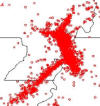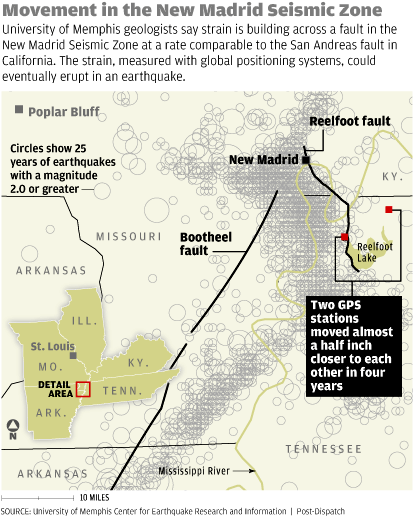Threat is increasing (???)
Will it or won't it?
 This webmaster's read is that a New Madrid area quake with magnitude above seven (the "big one") happens every 500 years or so (2312 AD), although there's a 10% chance the big one could happen right now. A lesser but still potent quake, above magnitude six, is overdue. Such a quake didn't kill anyone when it struck near Charleston MO in 1895. Scientists can't measure the pressures on the fault.
This webmaster's read is that a New Madrid area quake with magnitude above seven (the "big one") happens every 500 years or so (2312 AD), although there's a 10% chance the big one could happen right now. A lesser but still potent quake, above magnitude six, is overdue. Such a quake didn't kill anyone when it struck near Charleston MO in 1895. Scientists can't measure the pressures on the fault.
Scientists are trying to measure the movement of bedrock by a few millimeters a year, the width of a bottle cap, several feet below mud. They aren't certain how meaningful the measurements are, in the middle of a tectonic plate | with freezing and thawing | not enough expensive data collection points. Forces that cause quakes in the middle of a tectonic plate are much less understood than those where the edges of two plates are rubbing together.
USGS and CERI, Memphis, are leaders in studying the fault, and saying there IS a threat. The journal "Nature" tends to quote those who say the New Madrid threat isn't so bad.
Nothing big has happened lately on the fault. There are a handful of little quakes each week, around New Madrid, mostly five miles underground. Local folks have become accustomed to the ones they feel, and treat it like a passing thunderstorm or a passing train. You can count on a barrage of media questions, next time a noticeable quake goes off, of "Is it starting up again?" No scientist can really answer that.
| "The New Madrid fault is like a crack in the wall," comments Segall. "You try to cover it with plaster, but the crack reappears over and over again. It's always going to be there, because it's a preexisting weakness. -- Stanford Univ. |
 Here are news stories of their evolving attempts and conflicting conclusions. Some numbers and assumptions may be outdated. Research and scientific consensus is continually changing.
Here are news stories of their evolving attempts and conflicting conclusions. Some numbers and assumptions may be outdated. Research and scientific consensus is continually changing.
notsobad - Threat "significantly overestimated" -- April 1999 Northwestern Univ study: Seth Stein | + Mar 2007 good AP story contrasts Stein with other experts
Hazards overestimated? - long article by Seth Stein and others
Summary abstract of scientific article by Stein and others
nov1999 - "is indeed a threat, which contradicts the April study" -- Karl Mueller, Univ. of Colorado
june2005 - Strain is building: two monitoring stations on opposite sides of fault seems to move half an inch closer together. Other researchers skeptical.
| Scientists now know that the North American plate twice tried to break apart in the middle as continents drifted and pushed together over the past 700 million years or so. Although the split didn't happen, the stress left scars in Earth's crust 10 to 15 miles deep that still have sections that try to slide alongside each other and move upward. Zoback and colleagues first proposed five years ago that what's aggravated the faults in more recent geologic time has been a rebound effect on crust that was pushed down by ice-age glaciers that crept as far south as central [& southern] Illinois. - 700million years ago |
Aligns with NM zone; 65-70 Million years ago
Engineering Geology
Volume 81, Issue 2, October 2005, Pages 179-201
C.E. Bexfield and others
We have mapped an intricate zone more than 8 km wide of high-angle faults in Mississippi embayment sediments localized over Paleozoic bedrock faults that trend north to northeast, parallel to the Ohio River.
These faults align with the pattern of epicenters in the New Madrid seismic zone. The largest fault, the Olmsted fault, underwent principal displacement near the end of the Cretaceous Period 65 to 70 million years ago. Strata of this age (dated via fossil pollen)
Olmsted fault (near Paducah)
---
Ky emergency folks say threat is overblown, creating extra construction cost. Political pressure? 2003 story story
- Ky says too much construction data come from Calif. faults which are different
|
|
|
A bald eagle is ever vigilant |
Nah, it isn't moving much - St. Louis Post 2005
July 2005 - Debate over need for seismic building strength at St. Louis; river bridges strengthened The Reelfoot fault is building a pressure that could make it buckle again. Should St. Louis adopt strict building codes for a 1 in 500 year event, and do expensive retrofits? Anheuser Busch believes in preparation. This story has many good details.

Offsite
On the rebound from the ice age. Eric Calais, Purdue, GPS.
Ground movement - 11 GPS monitors. Two millimeters per year, "give or take"
Not significantly different from random - Glen Mattoli, U-Ark 2006 local copy
"As far as we know, the reason we get earthquakes is because of applied stress related to the motion of plates." But in the nation's heartland, this reason does not apply, and no theory has fully explained why large earthquakes may have occurred there. The Mississippi River basin further complicates regional studies, because the unstable, shifting sand and mud make it difficult to isolate any significant movement." --Glen Mattioli, professor of geosciences, UArk, Fayetteville.
Seth Stein of Northwestern Univ. - his web pages - downplays the threat
http://www.northwestern.edu/newscenter/stories/2006/12/madrid.html Stein, elaborated.
Stein says NM is dying -- maybe - MissouriNet
AUDIO: Bob Priddy interviews Professor Stein (17 min MP3)
TRANSCRIPT: Eugene "Buddy" Schweig on CNN-Lou Dobbs, 2005 (near end of transcript)
Insurance Journal: Scientists disagree - 2007
Stanford Report, 2000, "threat all too real" - Kenner and Segall
http://news-service.stanford.edu/news/2000/october4/newmadrid-104.html
Berkeley 2003: strain "not significantly greater than zero"
http://seismo.berkeley.edu/seismo/annual_report/ar02_03/node34.html
Powered by Show-Me.net
